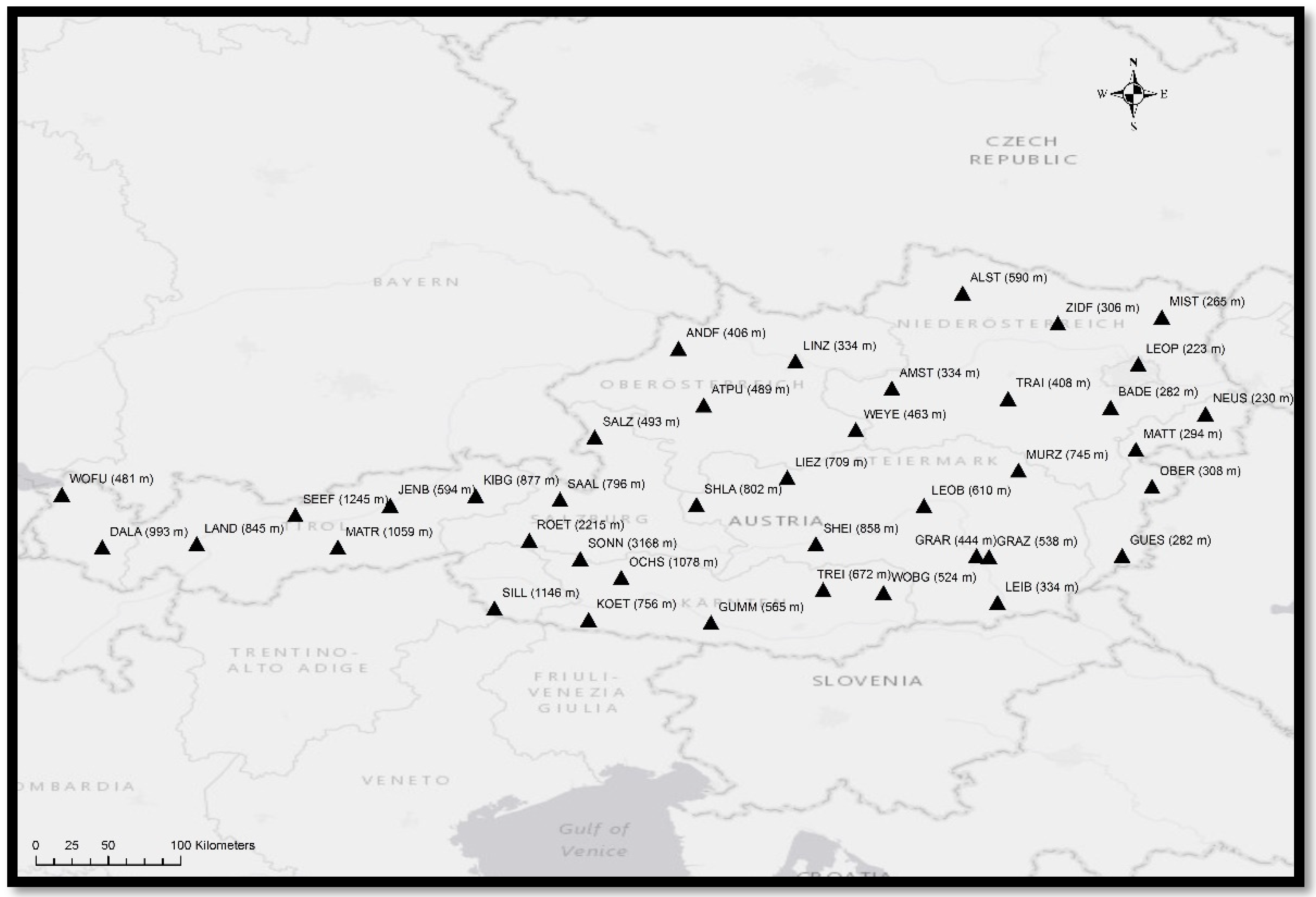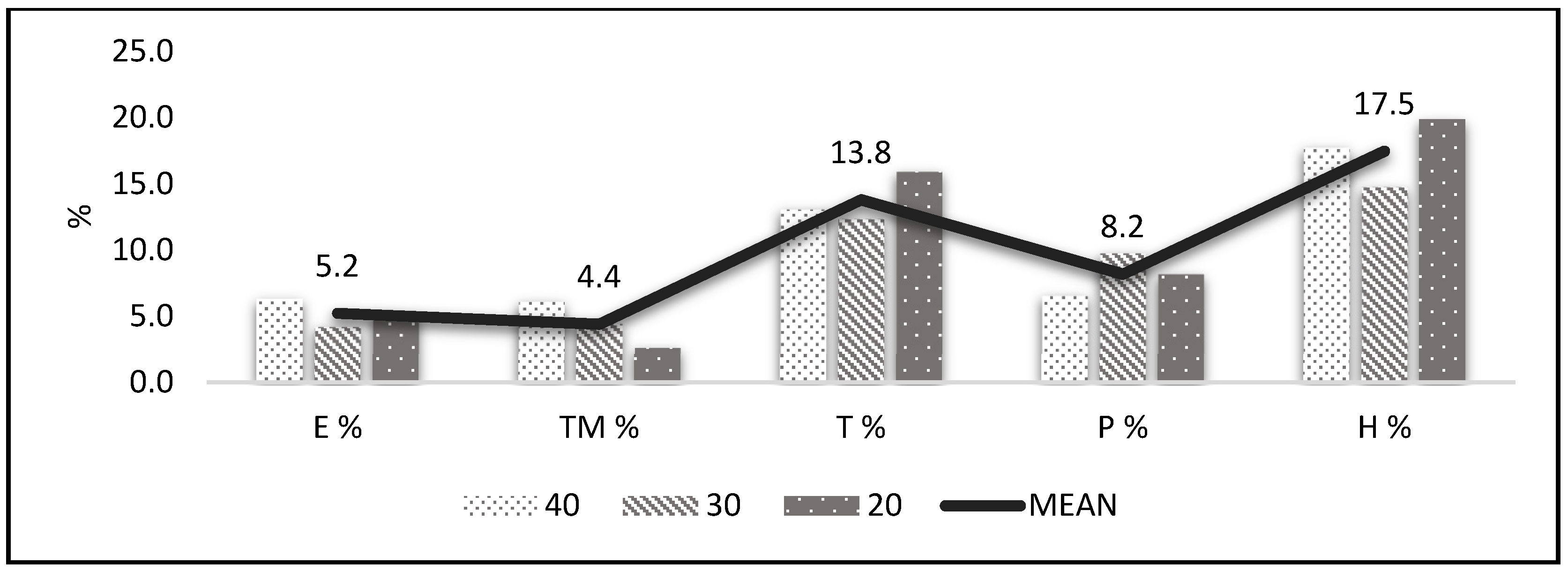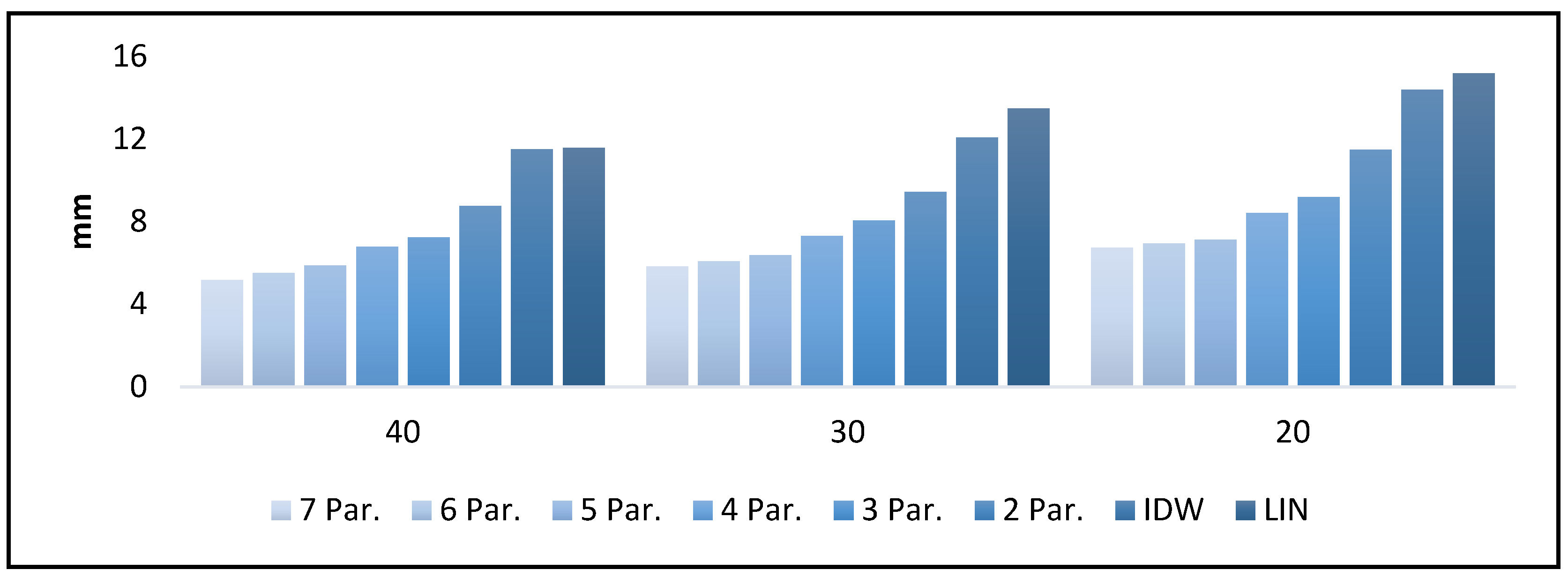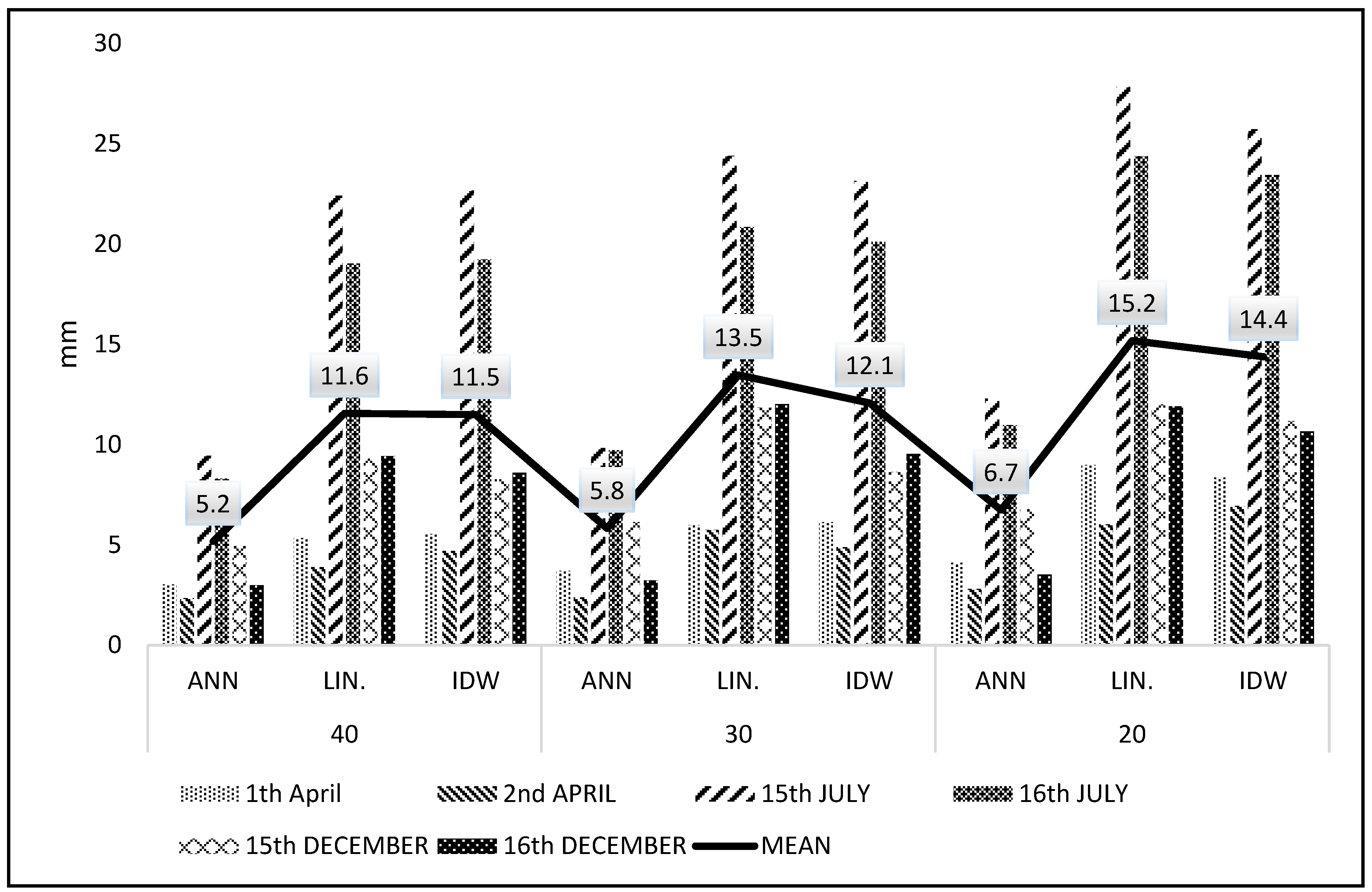Spatial Interpolation of GNSS Troposphere Wet Delay by a Newly Designed Artificial Neural Network Model
Abstract
1. Introduction
2. Materials and Methods
2.1. Artificial Neural Network (ANN) Model
2.2. Inverse Distance Weighted (IDW) Interpolation Method
2.3. Linear Interpolation Method (LIN)
3. Results
4. Discussion
Funding
Acknowledgments
Conflicts of Interest
References
- Niell, A. Global mapping functions for the atmosphere delay at radio wavelengths. J. Geophys. Res. Solid Earth 1996, 101, 3227–3246. [Google Scholar] [CrossRef]
- Böhm, J.; Niell, A.; Tregoning, P.; Schuh, H. Global Mapping Function (GMF): A new empirical mapping function based on numerical weather model data. Geophys. Res. Lett. 2006, 33. [Google Scholar] [CrossRef]
- Hopfield, H. Two-quartic tropospheric refractivity profile for correcting satellite data. J. Geophys. Res. 1969, 74, 4487–4499. [Google Scholar] [CrossRef]
- Saastamoinen, J. Contributions to the theory of atmospheric refraction. Bull. Géodésique 1972, 105, 279–298. [Google Scholar] [CrossRef]
- Goad, C.; Goodman, L. Modified Hopfield tropospheric refraction correction model. In Proceedings of the Fall Annual Meeting American Geophysical Union, San Francisco, CA, USA, 12–17 December 1974; p. 1106. [Google Scholar]
- Black, H.D. An easily implemented algorithm for the tropospheric range correction. J. Geophys. Res. Solid Earth 1978, 83, 1825–1828. [Google Scholar] [CrossRef]
- Davis, J.; Herring, T.; Shapiro, I.; Rogers, A.; Elgered, G. Geodesy by radio interferometry: Effects of atmospheric modeling errors on estimates of baseline length. Radio Sci. 1985, 20, 1593–1607. [Google Scholar] [CrossRef]
- Askne, J.; Nordius, H. Estimation of tropospheric delay for microwaves from surface weather data. Radio Sci. 1987, 22, 379–386. [Google Scholar] [CrossRef]
- Mendes, V. Modeling the Neutral-Atmospheric Propagation Delay in Radiometric Space Techniques; UNB Brunswick: Fredericton, NB, Canada, 1999. [Google Scholar]
- Selbesoglu, M.O. Evaluation of Precipitable Water Vapor Derived From Global Navigation Satellite System Observations based on Troposphere Model. Feb-Fresenius Environ. Bull. 2017, 26, 3924–3929. [Google Scholar]
- Al-Shaery, A.; Lim, S.; Rizos, C. Investigation of different interpolation models used in Network-RTK for the virtual reference station technique. J. Glob. Position. Syst. 2011, 10, 136–148. [Google Scholar] [CrossRef]
- Gumus, K.; Selbesoglu, M.O.; Celik, C.T. Accuracy investigation of height obtained from Classical and Network RTK with ANOVA test. Measurement 2016, 90, 135–143. [Google Scholar] [CrossRef]
- Zheng, D.; Hu, W.; Wang, J.; Zhu, M. Research on regional zenith tropospheric delay based on neural network technology. Surv. Rev. 2015, 47, 286–295. [Google Scholar] [CrossRef]
- Ding, M. A neural network model for predicting weighted mean temperature. J. Geod. 2018, 92, 1187–1198. [Google Scholar] [CrossRef]
- Rodrigues, E.R.; Oliveira, I.; Cunha, R.; Netto, M. DeepDownscale: A deep learning strategy for high-resolution weather forecast. In Proceedings of the 2018 IEEE 14th International Conference on e-Science (e-Science), Amsterdam, The Netherlands, 29 October–1 November 2018; pp. 415–422. [Google Scholar]
- Benevides, P.; Catalao, J.; Nico, G. Neural Network Approach to Forecast Hourly Intense Rainfall Using GNSS Precipitable Water Vapor and Meteorological Sensors. Remote Sens. 2019, 11, 966. [Google Scholar] [CrossRef]
- Manzato, A.; Pucillo, A.; Cicogna, A. Improving ECMWF-based 6-h maximum rain using instability indices and neural networks. Atmos. Res. 2019, 217, 184–197. [Google Scholar] [CrossRef]
- Pereira, S.; Canhoto, P.; Salgado, R.; Costa, M.J. Development of an ANN based corrective algorithm of the operational ECMWF global horizontal irradiation forecasts. Sol. Energy 2019, 185, 387–405. [Google Scholar] [CrossRef]
- Paras, S.M.; Kumar, A.; Chandra, M. A feature based neural network model for weather forecasting. Int. J. Comput. Intell. 2009, 4, 209–216. [Google Scholar]
- Hayati, M.; Mohebi, Z. Application of artificial neural networks for temperature forecasting. World Acad. Sci. Eng. Technol. 2007, 28, 275–279. [Google Scholar]
- Hung, N.Q.; Babel, M.S.; Weesakul, S.; Tripathi, N. An artificial neural network model for rainfall forecasting in Bangkok, Thailand. Hydrol. Earth Syst. Sci. 2009, 13, 1413–1425. [Google Scholar] [CrossRef]
- Abhishek, K.; Singh, M.; Ghosh, S.; Anand, A. Weather forecasting model using artificial neural network. Procedia Technol. 2012, 4, 311–318. [Google Scholar] [CrossRef]
- Gavili, S.; Sanikhani, H.; Kisi, O.; Mahmoudi, M.H. Evaluation of several soft computing methods in monthly evapotranspiration modelling. Meteorol. Appl. 2018, 25, 128–138. [Google Scholar] [CrossRef]
- Naganna, S.R.; Deka, P.C.; Ghorbani, M.A.; Biazar, S.M.; Al-Ansari, N.; Yaseen, Z.M. Dew point temperature estimation: Application of artificial intelligence model integrated with nature-inspired optimization algorithms. Water 2019, 11, 742. [Google Scholar] [CrossRef]
- Zheng, Y.; Feng, Y.; Bai, Z. Grid residual tropospheric corrections for improved differential GPS positioning over the Victoria GPS Network (GPSnet). Positioning 2005, 1. [Google Scholar] [CrossRef][Green Version]
- Pace, B.; Pacione, R.; Sciarretta, C.; Vespe, F. Estimating Zenith Total Delay Residual Fields by using Ground-Based GPS network. In Proceedings of the XX EUREF Symposium, Gävle, Sweden, 2–5 June 2010. [Google Scholar]
- Webley, P.; Bingley, R.; Dodson, A.; Wadge, G.; Waugh, S.; James, I. Atmospheric water vapour correction to InSAR surface motion measurements on mountains: Results from a dense GPS network on Mount Etna. Phys. Chem. Earth Parts A/B/C 2002, 27, 363–370. [Google Scholar] [CrossRef]
- Emardson, T.; Simons, M.; Webb, F. Neutral atmospheric delay in interferometric synthetic aperture radar applications: Statistical description and mitigation. J. Geophys. Res. Solid Earth 2003, 108. [Google Scholar] [CrossRef]
- Janssen, V.; Ge, L.; Rizos, C. Tropospheric corrections to SAR interferometry from GPS observations. Gps Solut. 2004, 8, 140–151. [Google Scholar] [CrossRef]
- Zhang, J. Precise estimation of residual tropospheric delays in a spatial GPS network. In Proceedings of the National Technical Meeting of the Satellite Division of the Institute of Navigation, ION GPS/1999, Nashville, TN, USA, 14–17 September 1999; pp. 1391–1401. [Google Scholar]
- Schüler, T. The TropGrid2 standard tropospheric correction model. Gps Solut. 2014, 18, 123–131. [Google Scholar] [CrossRef]
- Dach, R.; Hugentobler, U.; Fridez, P.; Meindl, M. Bernese GPS software version 5.0. Astron. Inst. Univ. Bern 2007, 640, 114. [Google Scholar]
- Shepard, D. A two-dimensional interpolation function for irregularly-spaced data. In Proceedings of the 23rd ACM national conference, New York, NY, USA, 27–29 August 1968; pp. 517–524. [Google Scholar]
- De Haan, S. National/Regional Operational Procedures of GPS Water Vapour Networks and Agreed International Procedures; WMO: Geneva, Switzerland, 2006; Volume 1340, p. 20. [Google Scholar]





| 1 April | ZWD | Latitude | Longitude | H | P | T | TM | E | ZWD |
| Correlation | 0.29 | 0.54 | −0.6 | 0.6 | 0.63 | 0.44 | 0.64 | 1 | |
| N | 959 | 959 | 959 | 959 | 959 | 959 | 959 | 959 | |
| 2 April | ZWD | Latitude | Longitude | H | P | T | TM | E | ZWD |
| Correlation | 0.22 | 0.55 | −0.88 | 0.89 | 0.88 | 0.62 | 0.88 | 1 | |
| N | 924 | 924 | 924 | 924 | 924 | 924 | 924 | 924 | |
| 15 July | ZWD | Latitude | Longitude | H | P | T | TM | E | ZWD |
| Correlation | 0.48 | 0.56 | −0.74 | 0.75 | 0.7 | 0.59 | 0.67 | 1 | |
| N | 953 | 953 | 953 | 953 | 953 | 953 | 953 | 953 | |
| 16 July | ZWD | Latitude | Longitude | H | P | T | TM | E | ZWD |
| Correlation | 0.34 | 0.6 | −0.83 | 0.83 | 0.81 | 0.64 | 0.78 | 1 | |
| N | 953 | 953 | 953 | 953 | 953 | 953 | 953 | 953 | |
| 15 December | ZWD | Latitude | Longitude | H | P | T | TM | E | ZWD |
| Correlation | 0.49 | 0.4 | −0.73 | 0.74 | 0.63 | 0.56 | 0.71 | 1 | |
| N | 956 | 956 | 956 | 956 | 956 | 956 | 956 | 956 | |
| 16 December | ZWD | Latitude | Longitude | H | P | T | TM | E | ZWD |
| Correlation | 0.37 | 0.69 | −0.53 | 0.56 | 0.3 | 0.73 | 0.58 | 1 | |
| N | 953 | 953 | 953 | 953 | 953 | 953 | 953 | 953 | |
| Mean | ZWD | Latitude | Longitude | H | P | T | TM | E | ZWD |
| Correlation | 0.37 | 0.56 | −0.72 | 0.73 | 0.66 | 0.60 | 0.71 | 1 |
© 2019 by the author. Licensee MDPI, Basel, Switzerland. This article is an open access article distributed under the terms and conditions of the Creative Commons Attribution (CC BY) license (http://creativecommons.org/licenses/by/4.0/).
Share and Cite
Selbesoglu, M.O. Spatial Interpolation of GNSS Troposphere Wet Delay by a Newly Designed Artificial Neural Network Model. Appl. Sci. 2019, 9, 4688. https://doi.org/10.3390/app9214688
Selbesoglu MO. Spatial Interpolation of GNSS Troposphere Wet Delay by a Newly Designed Artificial Neural Network Model. Applied Sciences. 2019; 9(21):4688. https://doi.org/10.3390/app9214688
Chicago/Turabian StyleSelbesoglu, Mahmut Oguz. 2019. "Spatial Interpolation of GNSS Troposphere Wet Delay by a Newly Designed Artificial Neural Network Model" Applied Sciences 9, no. 21: 4688. https://doi.org/10.3390/app9214688
APA StyleSelbesoglu, M. O. (2019). Spatial Interpolation of GNSS Troposphere Wet Delay by a Newly Designed Artificial Neural Network Model. Applied Sciences, 9(21), 4688. https://doi.org/10.3390/app9214688





